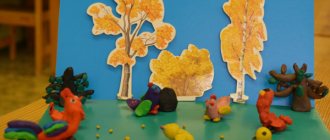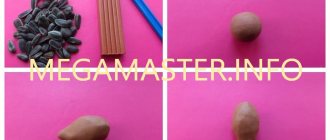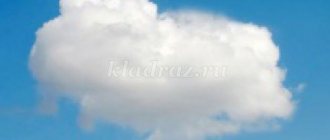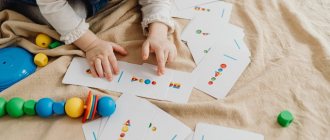Preview:
Abstract of the GCD on artistic and aesthetic development in the 2nd junior group (modeling) "Let's make wheels for a car"
Integration of educational areas: cognitive development, physical development, artistic and aesthetic development, speech development, social and communicative development
Objectives: Learning to create balls from plasticine by rolling it between your palms, flattening it with your fingers. Development of fine motor skills and imagination.
Materials and equipment: Pictures of a car without wheels, a toy car, plasticine, napkins
Logic of educational activities: The teacher asks the children a riddle:
“Carries cargo back and forth,
Will never get tired.
There are also headlights, steering wheel, cabin,
After the children guess the riddle, the teacher takes the car out of the box. The children look at it, name its parts, name the color, and remember what they rode on it.
Then the teacher plays the game “Sparrows and the Car.” One child, representing a car, is given a steering wheel. Other children play the role of sparrows. The teacher says: “Sparrows! “Children sparrows begin to run around the room, chirping cheerfully. The teacher gives the command “Car!” the sparrows are running away,” The car is moving and buzzing: “Beep! "
Then the children sit down at the tables. The teacher hands out pictures to the children. He asks them to tell what is drawn on them. The children say that this is a car.
The teacher draws the children's attention to the fact that cars do not have wheels. He asks what is missing? Then he offers to help the car and make wheels for it.
The teacher shows how to make wheels, distributes handouts, and the children get to work. The teacher helps each child, comments on his own actions and the child’s actions. The teacher praises the children. The teacher conducts breathing exercises:
“Cars are flying along the highway -
Everyone is in a hurry and buzzing.
We pump up the tires
We breathe many times in a row"
(Children stand slightly slouched, head lowered, drop lower one time, arms hanging down - inhale, two times back to the starting position - exhale. The exercise is repeated 4 times)
The teacher once again thanks the children for their good work, now all the cars can hit the road.
Progress of activities:
Bunny comes to visit the children.
Z. - Hello guys. Do you recognize me? Who am I? That's right, Bunny. I came to congratulate you on the beginning of the school year. I wanted to go visit the bear today and congratulate him, do you want to come with me?
V. - Guys, the forest is very far away. What can you use to go to the forest?
Z. – “My truck is a truck ,
Here is the cab, steering wheel and body,
She needs the body for cargo.
Bunny sitting in the back
He's looking at the wheels."
V. - Guys, look what happened to Zayka’s car ?
Z. - What should I do now?
V. – Don’t worry, Bunny, we have a workshop and the guys will be able to fix your car . Guys, can we help Bunny?
V. - Let's go to our workshop. Here are more cars , but not trucks, but cars . Now we can all go into the forest together, each in our own car .
V. - Guys, can we go to them? Why? What should be done? What wheel shape?
— To repair our cars , we need to warm our hands.
“We took plasticine into our hands
And we drove around a little
And then pressed lightly
And we weren’t at all tired.”
V. – Look carefully at how you and I will make wheels. First we will roll out a piece of plasticine. Then we apply it to the car and press lightly . What happened? These are the wheels you will attach to your car .
Pay attention to the sequence of work.
You can start working.
Independent work of children.
Offer to go to the forest in cars .
Physical education lesson: The song “ Machine ”
Children imitate the movements of driving a car .
Approaching the “den”
where the bear sleeps. They wake him up.
The game “At the Bear in the Forest”
.
Notes on sculpting "Sun" in the second junior group Notes on sculpting "Sun" in the 2nd junior group Purpose: to learn how to sculpt simple objects consisting of several parts of different shapes.
Summary of GCD for modeling in the second junior group “A friend for Mishka is a bunny” Summary of GCD for sculpting in the 2nd junior group “Friend for Mishka is a bunny” Objectives: To develop children’s interest in sculpting familiar objects consisting.
Abstract of the GCD for sculpting in the second junior group “Mouse-norushka” Program content: Educational objectives: Teach children to sculpt a mouse based on an egg-shaped shape. Show ways to create expressiveness.
Abstract of educational activities on object modeling in the second junior group “Cheerful Tumbler” Integration of educational areas: artistic and aesthetic development, social and communicative development; speech development, cognitive.
Notes on traffic rules in the second junior group “I’ll start my car” Materials and equipment: cars and trucks, a box of beans, figures of pedestrians (men from the LEGO set, model “On the streets.
Summary of the GCD lesson on sculpting “Make the Sun” in the second junior group Summary of GCD lesson on sculpting “Make the Sun” in the 2nd junior group Shaykhavova R. A. Goal: learn to sculpt simple objects consisting of several.
Summary of GCD for modeling in the second junior group “Pyramid” Purpose: To learn to compose an object from several parts of different sizes. Educational objectives: - to evoke a joyful mood and satisfaction in children. Notes on sculpting in the second junior group “This amazing underwater world!” Topic: “This amazing underwater world!” (plot modeling). Age group: second youngest. Type of activity: productive activity. Summary of GCD for modeling in the second junior group “Dymkovo Ducks” Objectives: 1. Continue to introduce children to the Dymkovo pattern 2. Develop the ability to make a traditional pattern 3. Cultivate a love for.
Summary of GCD for sculpting in the second junior group “Tank” GCD for sculpting in the second junior group. Topic: "Tank". Goal: to consolidate the ability to sculpt a tank from separate parts, to correctly convey the shape.
Liliya Stepanova
Summary of a lesson on modeling from plasticine in the second junior group “Truck”
Purpose of the lesson : Learning to create balls from plasticine by rolling it between your palms. Development of fine motor skills and imagination.
Preview:
Sculpting lesson notes
Topic: “Modeling a car”
Goal: To develop skills in sculpting a car from rolled out balls.
- Continue to teach children to sculpt an object consisting of several parts of the same shape, but of different sizes.
- Develop speech and attention.
- Cultivate a sense of compassion for others.
Materials: salt dough, soft toy Murzik the cat, napkins, napkins for modeling.
There's a knock on the door. Guys, someone came to visit us, I’ll go and have a look. The cat Murzik comes in.
Say hello to the guys! What a beautiful cat, fluffy and soft.
Murzik, you are so scared, who scared you so much? Guys, when I was walking towards you, I saw something like that on the street, they were honking, driving fast, fast, beeping (honking), I was so scared, what was it?
Educator: Children, what do you think scared our cat so much?
Murzik, sit and listen, the children will tell you everything they know about cars.
There are toy cars on the table.
Educator: Children, what do you see on the table? These are cars, how many are there?
Educator: This is a passenger car, it has wheels, windows, a steering wheel.
What kind of car is this?
Educator: Do you know what this car is called?
This is a truck, it has a body, windows, and a steering wheel. The truck can carry,
various loads in its body. Ask one of the children to take the cubes and unload them.
Can we transport the cubes in a small car?
Murzik, now you know what cars are, what kinds of cars there are.
Guys, when Murzik goes home, how can he cross the road? Are there cars driving there?
While the music is playing, you drive like a car, only the music stops playing and you stop.
Murzik, now the guys will show you how you can make small cars from salt dough at home.
II. Main part.
Familiarity with the depicted subject. Machine show.
Showing the sequence of actions and sculpting techniques.
To make a passenger car, you first need to roll one large ball, roll it between your palms into an oval shape. Roll four small balls from black dough - these will be wheels and attach to the bottom. Then you can attach the lights, polka dots and windows.
III. Summary of the lessons.
Review of finished works. Murzik the cat praises the children for their completed cars.
On the topic: methodological developments, presentations and notes
Lesson notes on visual arts (modeling - experimentation). Topic: “Tili-tili dough...”
Abstract of GCD on artistic creativity (Modeling) “Fire crew”. Senior group. Theme: Fire Safety.
We came to the garden. Here is a pumpkin, and here is a tomato. Here is cabbage, here is lettuce, Cumin, potatoes, artichoke, and a parsley root.
Lesson notes "Kolobok".
Goal: To create conditions for the development of cognitive interest in depicting wild animals using the sculpting method. Pedagogical objectives: Educational: - To clarify children’s knowledge about wild animals.
Summary of a lesson in fine arts (modeling) in the preparatory group on the topic: “Teremok”.
Lesson notes for the senior group. Modeling Topic: “Wild animals”.
Source of the article: https://nsportal.ru/detskiy-sad/applikatsiya-lepka/2020/10/24/konspekt-zanyatiya-po-lepke-tema-lepka-avtomobilya
Summary of a comprehensive lesson in the middle group: traffic rules and modeling “Truck”
Complex lesson: Traffic rules and modeling “Truck”
(in the second junior group - at the end of the school year, in the middle group) Objectives: Clarify children’s understanding of the street, roadway, sidewalk. To consolidate some rules for the movement of pedestrians on the street, the concepts of “crossing” and “pedestrian”. Strengthen children's understanding of the purpose of traffic lights for cars and people. Strengthen modeling techniques: rolling the dough between your palms; Practice using the flattening technique”; Strengthen the ability to connect parts, pressing them tightly to each other; Cause a positive emotional response to the overall result; Encourage the need to follow traffic rules. Demonstration material: model of the roadway, plasticine craft “Truck”, image of a traffic light. Handouts: plasticine, modeling boards, sticks (wooden toothpicks without sharp ends).
Progress of the lesson
- Guys, today we have an unusual activity.
We have a lesson with a surprise. Before I show you the surprise, you need to answer my questions. You are ready? - What is this? To help you, my friend, The path is dangerous, Lights are burning day and night, Green, yellow, red. — That's right, it's a traffic light. Who remembers the poem about traffic lights? - Well done boys! What do you think, what is a traffic light for? ( to pass the roadway so that pedestrians and cars move according to the rules
) - You were able to answer my questions, so I will show you the surprise I have prepared (the teacher opens a fabric-covered model of the roadway).
-What do you think it is? ( This is part of the road
).
- Look carefully and show me the way. Guys, the road is called “roadway” by another name. — Is it possible to walk on the road, why? —Where do pedestrians go? — What else interesting did you notice? ( traffic light, pedestrian crossing
) - Can I cross the road anywhere?
— Look carefully at the layout and tell me what’s missing here? ( cars
) - Guess the riddle:
For this horse, food is Gasoline, and oil, and water, He does not graze in the meadow, He rushes along the road. — That's right, this is a car
.
- Now you and I will build cars for our road ourselves. To do this, you need to all sit down at the tables. - First, you and I will do exercises for our hands: Physical exercise “We are drivers” (children must show movements) We are driving, we are driving a car (moving the steering wheel)
Press the pedal
(stretch your arms forward)
Turn on the gas, turn it off
(turn the lever towards you, from ourselves)
We look intently into the distance
(palm to forehead)
The wipers count the drops To the right, to the left - cleanliness!
(“windshield wipers”)
The wind ruffles your hair
(ruffle your hair with your fingers)
We are drivers anywhere!
(right thumb up)
- Look at my craft, what does it look like?
— What parts does a truck consist of? ( from wheels, body, cabin
) In order to make wheels, you need to roll out 4 identical balls.
There are 4 pieces of plasticine in front of you, take a piece of plasticine and roll out the ball. Look carefully, I have a ball. I will slightly “flatten” this ball and I will get a small cake. I have 4 of these parts. I take a wooden stick and thread a wheel (the resulting part) onto the end of this stick. On the other end of the stick is the second piece. I also thread the remaining two wheels onto the ends of the second stick. Afterwards we take a large block of plasticine. Place another small block of plasticine on top of a large block of plasticine. Press tightly against each other. Now we put it on 2 wooden sticks. Our truck is ready. Result of the lesson: Designing a layout of the roadway with your own cars (you can do vocabulary work with the word “Parking”)
We recommend watching:
Summary of GCD in the middle group of a preschool educational institution on traffic rules. Summary of a lesson on traffic rules in the middle group. Traffic rules Summary of a lesson on traffic rules in kindergarten in the middle group. Road signs
Similar articles:
Summary of a lesson on traffic rules in the middle group on the topic “Rules of conduct on the railway”
Summary of a lesson on traffic rules in the middle group. Crossroads
Summary of a lesson on traffic rules in the junior group of kindergarten according to the Federal State Educational Standard. Topic: Trolleybus
Lesson summary - excursions on traffic rules in the middle group of kindergarten
Conversation about traffic rules in the middle group






